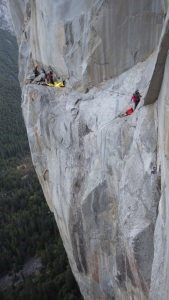In an interesting article in the magazine Nautilus, J.B. MacKinnon, reports that a brain scan (fMRI) of free solo climber, Alex Honnold’s brain explains why he is so willing to risk his life to climb rocks without a rope. The fear circuitry in his brain is dysfunctional.

You may have seen the cover of National Geographic featuring free solo climber Alex Honnold climbing Half Dome in Yosemite Valley without a safety rope. This death-defying activity is called free-solo climbing. Free solo climbing is to mountain climbing what going over Niagara Falls in a barrel is to white water kayaking. One activity is a dare-devil risk of life and the other is about managing danger with skill, in pursuit of adventure. How can we comprehend someone not being overcome with fear at the prospect of falling hundreds of feet to their death as they cling to a rock face by fingertips? As MacKinnon describes in his article, functional magnetic resonance studies (fMRI) of Honnold’s brain performed by neuroscientist Jane Joseph provides the answer. The threat detection and fear circuitry in Honnold’s brain is dysfunctional.
I remember when my son and I climbed Half Dome with my friend Tom. The first time that massive wall of granite came into view as we rounded the bend driving into the Valley we all had the same reaction--our palms started to sweat. We all laughed. Riding safely inside the car the threat detection and fear circuitry inside our brains was doing its job. Always on guard and scouting ahead for danger the circuitry in our brains screamed--Hey! That’s dangerous! You are about to die!

The center of this threat detection circuitry in our brain is the amygdala, two almond sized clusters of neurons deep in the brain. Information from all our senses streams into the amygdala by high speed pathways, reaching the threat detection and fear center of the brain before sensory information goes to the cerebral cortex where consciousness arises. Rapidly calculating the complex stream of input from the external environment together with data about our internal bodily status and situational factors, the amygdala sifts through data and computes, searching for potential threats, and instantly sets us on a course to respond to the danger. All of this threat assessment is done unconsciously. The conscious brain is too slow and our conscious mind could not possibly retain all the information that the brain’s threat detection circuitry crunches automatically. The instant it detects a sudden danger, the amygdala fires impulses to the hypothalamus to launch a coordinated bodily response to confront the danger. Our heart races, blood pressure jumps, muscles twitch, and our body sweats to prepare us to run or fight the deadly threat. As we drove into the Valley and saw that towering imposing face of granite, our amygdala was preparing us to run.
But we didn’t run. We went on to climb Half Dome and we were rewarded by a life-long memory of an experience and of being in an amazing place in nature that few will know. We didn’t run because the brain’s threat detection center is under control of the prefrontal cortex. An fMRI of our brain as we committed to climbing Half Dome would show intense activity in our prefrontal cortex, sending inhibitory signals to the amygdala to squelch its alarm. “Yes I know it is sketchy,” our prefrontal cortex tells our amygdala, “but I’ve got this.”
Fear is lifesaving. The bodily reactions that the amygdala launches, the familiar sensation we call fear, amplifies the cognitive ability and bodily power to levels well beyond our everyday capabilities. The fear circuit gives a petite woman the strength to lift a car to free a trapped child. When you are afraid you can hear a pin drop. Your mind races a mile a minute and time dilates. Honnold’s brain scan showed that his amygdala does not respond to danger. This dysfunction is very dangerous.
In my book, Why We Snap, I describe the brain’s threat detection circuitry in detail and present the interesting case of a woman known in the medical literature as SM, who has no fear because her amygdala was damaged by infection at a young age. The woman’s life story is harrowing. Without fear she overlooks even obvious threats in her environment. She does not learn from experience to avoid dangerous situations. As a consequence, she has experienced a harrowing number of life-threatening encounters. She has been held up at knifepoint and at gunpoint. She has been physically accosted. She was nearly killed as a victim of domestic violence. In all of these deadly encounters she never felt fear and she did not behave with any urgency or sense of desperation. Justin Feinstein of the University of Iowa who studied SM says, “It is quite remarkable that she is still alive.”
“Fear is a force that sharpens your senses,” writes Navy SEAL Marcus Luttrell. He and others who must perform under extreme danger utilize fear, and learn to manage and cope with it through willpower and commitment--courage. This is the prefrontal cortex acting to inhibit the amygdala. But the fMRI of Honnold’s brain did not show heightened activity in his prefrontal cortex. Heightened prefrontal cortex activity could have explained how he courageously perseveres in dangerous free soloing despite the enormous risk and fear of death that should ignite, but instead, his amygdala registers no fear. This new information about Alex Honnold presents a quandary. If Honnold has no fear as a result of his brain dysfunction, are his dare-devil stunts courageous? Can there be courage without fear? Is someone taking dangerous suicidal risks because they lack the brain function to perceive fear any different from marveling at a paraplegic who can feel no pain from sticking a needle into their flesh? Is it appropriate to encourage this behavior by elevating free solo stunts to celebrity status if this activity is rooted in dysfunction?
Honnold is a truly amazing and extremely talented climber, but sadly, history shows that free soloing rarely ends well. A gust of wind, a broken hold, a sudden start from an animal or wasp inside a crack as the climber slips fingers into it, all cause falls that are beyond the climber’s ability to control. When a person climbs with a safety rope, these mishaps rarely result in death, but in free soloing they always do.
There is a misperception perpetuated by some who claim free soloing is the ultimate extreme of rock climbing. It is not. Climbers do not use the rope to ascend the rock (unless they are doing a specialized type of climbing called “aid climbing” to ascend vertical or overhanging walls that have no hand or foot holds). The rope is never weighted, used only to catch them if they fall. So when a person climbs Half Dome using proper technique and mountaineering rope skills, he or she has climbed the route just as Honnold did--move for move--but they did not foolishly invite certain death to do it.
In fact, free soloing is far easier than climbing with a safety rope, because climbing with a rope requires much more strength, endurance, and skill to place the points of protection during the climb and to clip the safety rope into each protection point. To understand this, imagine doing a chin-up and then letting go with one hand. Now as you hang with one arm, your other hand sifts through pounds of gear attached to your harness, searching for the proper type of gear that can be wedged into a crack in front of your nose. Cracks come in all sizes, angles and positions relative to your desired climbing route. You must carry a bewildering array of different shapes, types, and sizes of gear to fit whatever crack nature may provide you on your route. With the selected piece of gear in hand (or often in your teeth), you now puzzle out how to fit it into the crack so that it will hold the enormous force of a person falling, but can still be removed by your partner when he or she follows up the rope behind you. This process can take a long time while you dangle by your fingertips. Several trials and errors may be required to try different types of gear until you find one that will fit snugly into the crack. This process of placing safety gear to climb with a rope requires an enormous amount of strength and skill. The whole time you may be hanging by one arm and a toe hold with hundreds of feet of air below you. With the piece of gear wedged into the crack you now reach down between your knees, while still doing the one-armed chin-up, to grab your rope, pull it up, and clip it into the safety anchor. If you fall, this point of protection, backed up by others you have already placed below, will catch you. Now you climb on, and you do the same thing every four yards or so.

Contrast that with someone who just climbs the same route as quickly as possible, carrying no heavy gear at all, and conserving strength by not having to stop and place the protective gear, but all the time risks ending their life in the next instant from a sudden slip. The situation is similar to the difference between going backpacking in the wilderness with a 50 pound pack filled with essential gear and provisions to survive in the wild, versus a person wandering into the backwoods with nothing but tennis shoes and a tee shirt. One is far easier to do than the other, but foolish. But if your brain lacks the ability to properly perceive fear, you can do dangerously foolish things.
Reference
MacKinnon, J.B. (2016) The strange brain of the world’s greatest solo climber. Nautilus, July/August, p. 82-95.
CONTENT PROVIDED BY
BrainFacts/SfN
Also In Emotions, Stress & Anxiety
Trending
Popular articles on BrainFacts.org

















